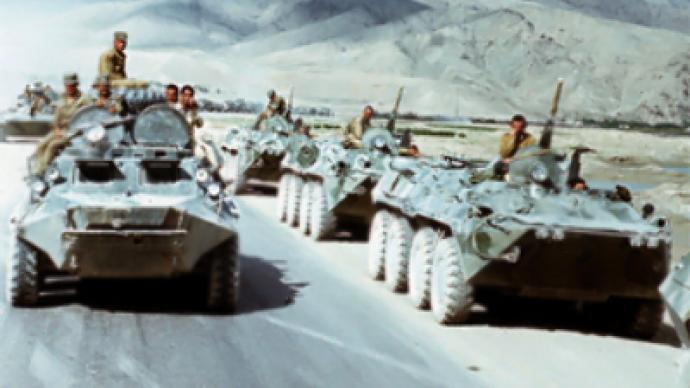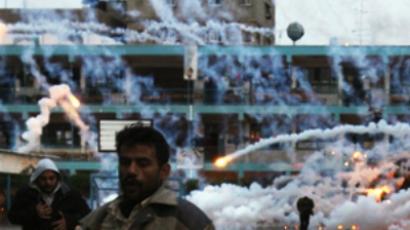Afghanistan: war on demand

Twenty years ago next Sunday, February 15, the last Soviet soldiers marched out of Afghanistan. The longest ‘hot’ conflict of the Cold war was over, but the spin wasn’t.
Even with the embers of the Cold war having given out their last whiff of smoke, the spin created around the Afghan conflict by every side involved, survives to this day, and is now in demand again.
Afghanistan as a special ‘field of spin’
Much has been written on that conflict and it’s hard to add anything new to the pile of the amassed military, historical, psychological and medical knowledge, but if we look upon that war from the angle of media spin, as many did already before us, we will see a unique situation.
Usually media spin precedes a war to make it acceptable to general public, then goes on during the war in order to hail victories, hush down the failures and spread disinformation that affects the enemy, and then stays on for a while after the war, to reaffirm the planted ideas about the rights and wrongs of the conflict in the minds of the public.
It happened that way with the Gulf war, with the invasion of Iraq in 2003, with Yugoslavia in 1999. The latter is the most perfect example of the media spin cycle, with the media actually proving to the worldwide audience that the humanitarian crisis in Kosovo started with the nonexistent Belgrade-backed campaign of ethnic cleansing rather then with the beginning of NATO air raids.
The spin stopped the moment when Kosovo Albanian armed groups found themselves the sole force on the ground, the only heirs to the whole region cleansed of its Serbian and Albanian population alike by the NATO bombs, but ready to be populated anew – by the returning Albanians only. That spin ended right after the war, but it worked its way into the people’s minds so deep that Kosovo’s independence turned out to be quite an easy ride for its supporters.
Afghanistan is different. The spin goes on there permanently for decades. Only the intensity and speed increase with every escalation, and then gets back to ‘normal’ when the escalation ends. Afghanistan is special in one sense: war there never stops, nor does the spin. Or, to be exact, the war, born and facilitated by spin, goes on and on, feeding on more spin.
The pre-spin background
The only considerably peaceful period in Afghanistan’s recent history is the era of the Afghan monarchy from 1919, the end of the Third Anglo-Afghan war, till the revolution of April 27, 1978. In the XIX Century and most of the XX Century Afghanistan as a country was isolated from the outside world except for the three attempts of the British to subdue it to their colonial rule. At those moments the Pashto and Uzbek tribes populating the country often built temporary alliances to fight off the invaders, but in times of relative peace they were isolated even from each other by the vast spaces and barely traversable mountainous terrain.
There were conflicts and wars between the tribes, and in the second half of the XX Century the Pashto peoples often fought each other, their allegiances divided between Pakistan and Afghanistan. Apart from that, fights between the Pashto and the Uzbeks became more often with the elementary development of communications and infrastructure brought about by the XX Century.
The factor of Islamic fundamentalism entered the scene in the second half of the XX Century and added to the fires of war periodically erupting here and there around the country. The notion of Afghan patriotism, therefore, was not based on the sentiment of nationhood, as only in the 1920–1960s was Afghanistan getting close to forming a single multi-ethnic nation. Later, conflict and war nullified the effects of that period, but was much more grassroots-related, standing on the simple notion of tribal ownership and control over certain areas of land in a mostly isolated country where a visit by a foreigner to a rural community was always an extraordinary event.
War revisited Afghanistan in 1979 with the beginning of the Soviet invasion, and war remains there to today. The hostilities started in earnest only in 1980, when the situation in the country became well-exposed to the influence from abroad on both sides, pro-government and anti-government, and Afghanistan smoothly sailed into the straits of the Cold war.
The soviet invasion – from spin-free to spun inside out
When Soviet troops marched into Afghanistan I was in my last year of high school. I remember it well: there was no spin on Afghanistan in our media. There was outright propaganda and it worked perfectly well: spin needs publicised facts to turn inside out or show at an angle, while propaganda is based on ignorance.
In 1979 the Soviet public knew nothing about Afghanistan beyond what it had seen in a much earlier TV series ‘The Mission in Kabul’ that depicted the genuinely heroic efforts of Soviet diplomats and spies in 1919–1922 aimed at ending British influence in the Central Asian underbelly of the Soviet Union. Afghanistan was perceived as a friendly neighbouring country, where a social-democratic revolution occurred in April, 1978. It was a country well on its way to join the fold of the permanent allies of the Soviet Union.
Before 1980 there was no intensive coverage of Afghanistan on Soviet television, and after a short period of hailing the successful reforms by Babrak Karmal’s government the country, in which Soviet soldiers fought and died, it fell back into relative oblivion until the days of Gorbachev’s Perestroika.
That was not the case with the democratic West. Media coverage of Afghanistan was not as much ‘hands-on’ as what we have today with correspondents ‘embedded’ with the troops – before the CIA operations with the Mujaheddin fighters commenced in 1980–81 there was virtually no opportunity for a Western correspondent to enter the country either through Pakistan or through the USSR.
The lack of footage was well compensated for by a great concerted effort in media spin: the Soviet invasion was branded ‘aggression’ long before the actual fighting started, if we do not count the initial assault on Hafizulla Amin’s palace by a group of KGB spetsnaz, of which the world still knew nothing at all. To understand the situation in the Western media at the time it is sufficient to look up the media campaign for the boycott of the Moscow Olympiad: it took much more newspaper space and media time than actual reports from Afghanistan.
The Soviet contingent entered Afghanistan to uphold a pro-Soviet government which had problems in the form of occasional mutiny by a regiment or two or by tribal separatism, but was not yet at war with its own people. From the point of view of international law the invasion was not kosher at all, but it was not outright illegal either. The Soviet troops entered the country on an invitation by its legitimate government, recognised by all the key members of the international community.
So, the spin was not based on matters of international law, it was much more intricate and elaborate. The spin doctors, at first those working for the intelligence community, later those who were in the media, took notice of Islamic fundamentalism as a relatively new movement gaining strength among the Pashto tribes, and concentrated on the notion of Soviet invaders being infidels and enemies of Islam and the Kabul government as traitors to the religion of the ancestors – collaborators of the invading infidels. The fact that among government loyalists there were many Uzbeks and members of other non-Pashto ethnic groups fanned the flames.
The spin that arrived too late
This was the beginning of the anti-Soviet jihad. The spin was instrumental in its making as much as other key factors. It started first with a series of U.S. intelligence propaganda operations aimed at the Pashto tribes, and with the competing efforts by the spiritual leadership of Iran and various Arab religious fundamentalist organisations in increasing their influence on the Afghan Islamic fundamentalists. Then it moved into the realm of the media and caused a massive press, radio and television campaign in support of the Afghan ‘fighters for their ancestral home and religion.’
As the war went on, escalating along the way, a drastic change occurred in Soviet public opinion. It was not so much prompted by the Western media spin – the Soviet people had very limited access to Western media – as by the steady flow into the country of closed coffins containing young Russian soldiers who died in the war, which was not being referred to as a war. The general attitude to the Soviet government’s efforts in Afghanistan became largely negative, and in the absence of free media it turned onto the veterans returning from the war and finding no place for themselves in the peaceful embrace of their Motherland.
By 1987-88 the Russian media were freer than anyone could have predicted in 1985 at the start of Perestroika. Then the Western spin on Afghanistan hit Russia in earnest, and, together with truthful accounts of the war published in the West and translated into Russian, a lot of unchecked information from unreliable foreign, as well as domestic, sources splashed over the Russian media, both print and electronic. The negative attitude turned into despise and humiliation.
I remember how in late 1987 two of my university friends went to the Sheremetevo airport to pick up a coffin containing their dead classmate, a student on a temporary one-year active duty commission as a Pashto interpreter with an airborne division. He had been killed in an ambush together with his divisional commander. When they arrived at the airport earlier than the truck provided by the military, the Aeroflot cargo staffers started kicking the coffin and badmouthing my friends and the dead officer, telling them to ‘take their box of rotting meat away’. Only the airport police saved the staffers from heavier injuries than a broken jaw and my friends from lengthy jail terms.
In February 1989 the Soviet troops were withdrawn. The general sentiment in Russian society turned again – this time to grief over the dead and pity for the veterans with injured bodies or souls. With the spin seemingly over, parallels were drawn between the fate of Vietnam veterans in the U.S. and Afghanistan veterans in Russia.
In my heart and mind Billy Joel’s song ‘Farewell Saigon’ sung together with the Musical Ensemble of the Russian Army, became the strongest symbol of reconciliation between the two opposite sides in the Cold war, who were now regretting their role in the conflicts they had entered out of idealism tightly mixed with the pragmatic purpose of geopolitical interest, and were now mourning their own and their enemies’ dead together.
Fruits of the spin
However, in Afghanistan, the war, and the spin, continued. They were picked up by others where the West and the Soviet Union had left them. Religious and ethnic differences and power ambitions of local warlords born by the nine-year-long war continued fuelling the conflict abandoned by the ‘civilized’ great powers to its own devices.
From the hot and bloody mist of that new civil war came the Taliban. It took the ‘civilized’ world a couple of years to grasp the picture. The new threat included an unlimited flow of illicit opiates (fundamental Islam prohibits alcohol consumption but is very mild on narcotics) and unprecedented opportunities for Islamic militants and terrorists presented by the new government of Afghanistan.
Spin specialists were called upon again, and within several months the perception of an evil state harbouring terrorists and drug dealers completely replaced the shock and stun of the first encounters with the Taliban.
Meanwhile the media coverage again omitted a few important facts. For instance: under Taliban the opium growing and processing of illicit drugs became organised and fell under tight control. Another was the fact that in the Taliban-held areas there were law and order, even if the law was Sharia and the order held together by fear of religious and physical punishment.
The picture was not pretty, but for millions of Afghanistan’s civilians it was the first form of peace they had known in decades. The allied operation to oust the Taliban brought the war back. Media coverage of the humanitarian catastrophe it caused was this time scarce, while the access to hundreds of thousands fleeing to Pakistan was not a problem.
Today’s spin is tomorrow’s sin
The problem was the spin: it always operates in clear categories of good and evil, which in most cases exist exclusively in the ‘field of spin’ but not in reality. How could the operation supposed to free the Afghan people from the tyranny of the Taliban cause something as evil as a flow of refugees into a neighbouring country?! Most of the mainstream media acted as if they didn’t even notice.
Today it is evident that the allied, as well as the single-handed efforts of the U.S., have not had the desired effect. The Taliban is alive and kicking. The foreign forces have trouble controlling the countryside where over 80% of the Afghan population lives. Allied attacks on the Taliban, due to mistakes and communication problems, often cause heavy civilian casualties.
The spin continues to run at full throttle once again. The new U.S. administration is preparing to shift the emphasis of its military involvement from Iraq to Afghanistan, which would mean an escalation of the conflict there nearly to the scale of the Soviet war of the 1980s. Washington is showing signs of willing to cooperate with Moscow in the fight against the Taliban and asking its European allies for more troops, and we see all this in the media…
…but do we see reports from the refugee camps in Pakistan, where frightened people are still waiting for the time when it will be safe to return to their homes? Do we see reports from the battlefields of the war against the Taliban? Are there many correspondents embedded with the U.S. or allied forces inside Afghanistan? Do we have any perception of what awaits American and European soldiers if their numbers in-country reach 100,000 and the war escalates into an all-out jihad?
The Taliban does present a prominent threat – not only to the Western world but also to the neighbouring countries in Central Asia, as well as southern Russia, and to moderate mainstream Islam as well. This time foreign soldiers and diplomats cannot just turn their backs and go – we are all committed to the creation of a democratic and peaceful Afghanistan. We are bound to cooperate in the effort necessary for its creation. The simple idea of asking questions first and shooting later may be the key to a successful fulfillment of this collective dream.
One of the big obstacles on that path is the Afghanistan spin, which started in the first months of the Soviet invasion and is still running to this day. Spin has a way of letting itself into the thinking and decision-making process of statesmen. It is a side effect, but it is strong enough to affect government policies and war plans. There is a good example in the recent past: Iraq’s alleged weapons of mass destruction.
It is known that a good liar has to believe his own lies so that he can deceive others. In the case of the media spin around the situation in Afghanistan, it would be great if those who conduct it avoid believing it themselves. The world will be much safer if they didn’t.
Evgeny Belenkiy, RT.














